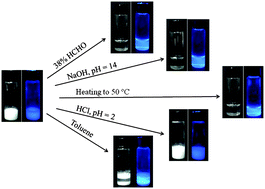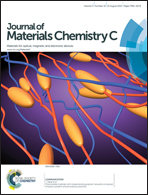Manipulation of multiple-responsive fluorescent supramolecular materials based on the inclusion complexation of cyclodextrins with Tyloxapol†
Abstract
A fluorescent supramolecular hydrogel was prepared by α-cyclodextrin (α-CD) and Tyloxapol, which can be considered as an oligomer of the nonionic surfactant polyoxyethylene tert-octylphenyl ether (Triton X-100, TX-100) with a polymerization degree below 7. For comparison, both Tyloxapol and TX-100 were selected to form hydrogels with α-CD to get more information about the interaction between different types of surfactants and cyclodextrin. These hydrogels have been thoroughly characterized using various techniques including phase behavior observation, transmission electron microscopy (TEM), field emission scanning electron microscopy (FE-SEM), fluorescence spectra, fluorescence microscopy observations, Fourier transform infrared (FT-IR) spectroscopy, 1H NMR, 2D 1H-1H ROESY NMR, small-angle X-ray scattering (SAXS), X-ray diffraction (XRD) and rheological measurements. The hydrogels of α-CD/Tyloxapol are responsive to external stimuli including temperature, pH and guest molecules, and present gelation-induced quenching fluorescence emission properties. The reason for this phenomenon may be that Tyloxapol molecules come into the cavity of α-CD and form the inclusion complexes. Due to the high electron density of the narrow cavity of α-CD, it induces the shift of the electron on the benzene ring which can weaken the π–π interaction and lead to the fluorescence quenching. Moreover, the hydrogel formed by α-CD/Tyloxapol is highly responsive to the formaldehyde (HCHO). The addition of a small amount of HCHO can induce a gel-to-sol transition. Interestingly, once the gel transforms into solution, it becomes fluorescent. This makes the α-CD/Tyloxapol hydrogel a promising candidate for HCHO detection and removal in home furnishings to reduce indoor environmental pollutants.


 Please wait while we load your content...
Please wait while we load your content...